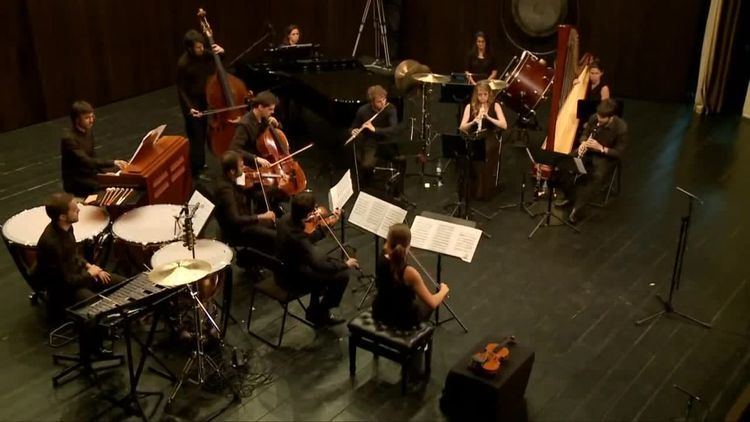 | ||
Prélude à l'après-midi d'un faune (L. 86), known in English as Prelude to the Afternoon of a Faun, is a symphonic poem for orchestra by Claude Debussy, approximately 10 minutes in duration. It was first performed in Paris on December 22, 1894, conducted by Gustave Doret. The flute solo was played by Georges Barrère.
Contents
Debussy's work later provided the basis for the ballet Afternoon of a Faun choreographed by Vaslav Nijinsky.
Background
The composition was inspired by the poem L'après-midi d'un faune by Stéphane Mallarmé. It is one of Debussy's most famous works and is considered a turning point in the history of music; Pierre Boulez considered the score to be the beginning of modern music, observing that "the flute of the faun brought new breath to the art of music."
About his composition Debussy wrote:
The music of this prelude is a very free illustration of Mallarmé's beautiful poem. By no means does it claim to be a synthesis of it. Rather there is a succession of scenes through which pass the desires and dreams of the faun in the heat of the afternoon. Then, tired of pursuing the timorous flight of nymphs and naiads, he succumbs to intoxicating sleep, in which he can finally realize his dreams of possession in universal Nature.
Paul Valéry reported that Mallarmé himself was unhappy with his poem being used as the basis for music: "He believed that his own music was sufficient, and that even with the best intentions in the world, it was a veritable crime as far as poetry was concerned to juxtapose poetry and music, even if it were the finest music there is." However, when Debussy invited Mallarmé to attend the premiere performance, Mallarmé wrote to Debussy afterwards: "I have just come out of the concert, deeply moved. The marvel! Your illustration of the Afternoon of a Faun, which presents a dissonance with my text only by going much further, really, into nostalgia and into light, with finesse, with sensuality, with richness. I press your hand admiringly, Debussy. Yours, Mallarmé."
Composition
The work is scored for three flutes, two oboes, cor anglais, two clarinets in A and B♭, two bassoons, four horns, two harps, two crotales and strings. In standard notation: 3 3[1.2.Eh] 2 2 – 4 0 0 0 – 1perc[crot] – 2hp – str (10').
Although it is tempting to call this piece a tone poem, there is very little musical literalism in the piece; instead, the slow and mediated melody and layered orchestration as a whole evoke the eroticism of Mallarmé's poem.
[This prelude] was [Debussy's] musical response to the poem of Stephane Mallarmé (1842–1898), in which a faun playing his pan-pipes alone in the woods becomes aroused by passing nymphs and naiads, pursues them unsuccessfully, then wearily abandons himself to a sleep filled with visions. Though called a "prelude," the work is nevertheless complete – an evocation of the feelings of the poem as a whole.
The Prélude at first listening seems improvisational and almost free-form; however, closer observation will demonstrate that the piece consists of a complex organization of musical cells, motifs carefully developed and traded between members of the orchestra. A close analysis of the piece reveals a high amount of consciousness of composition on Debussy's part.
The main musical themes are introduced by woodwinds, with delicate but harmonically advanced underpinnings of muted horns, strings and harp. Recurring tools in Debussy's compositional arsenal make appearances in this piece: extended whole-tone scale runs, harmonic fluidity without lengthy modulations between central keys, and tritones in both melody and harmony. The opening flute solo consists of a semitone descent to a tritone below the original pitch, and the subsequent ascent. The development of the slow main theme transitions smoothly between 9
8, 6
8, and 12
8 meters. Debussy enacts voicings and shading in his orchestration to a high degree, allowing the main melodic cell to move from solo flute to oboe, back to solo flute, then two unison flutes (yielding a completely different atmosphere to the melody), then clarinet, etc. Even the accompaniment explores alternate voicings: the flute duo's crescendo during their melodic cells accompany legato strings with violas carrying the soprano part over alto violins (the tone of a viola in its upper register being especially pronounced).
The composition totals 110 bars. If one counts the incomplete lines of verse as one, Mallarmé's text likewise adds up to 110 lines. The second section in D-flat starts at bar 55, exactly halfway through the work.
Ballet version
In 1912, the piece was made into a short ballet, with costumes and sets by painter Léon Bakst, which was choreographed and performed by renowned dancer Vaslav Nijinsky. It proved to be highly controversial because of the dancers' non-traditional movements and because of a moment in which the faun appears to masturbate.
Literature
In Thomas Mann's The Magic Mountain it is implied that protagonist Hans Castorp listened to Debussy's piece on a gramophone. In the book, the Prélude is one of his favorite recordings, and leads him to daydream about a faun playing pipes in an oneiric landscape.
